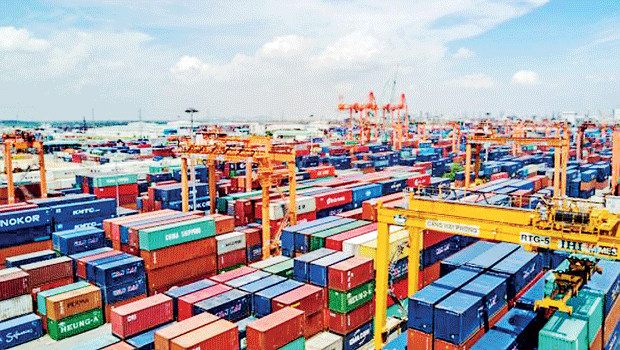22 Nov 2017 - {{hitsCtrl.values.hits}}

 Global trade is finally recovering, as is Asia’s trade. After underperforming the past two years, Asian trade is back at the forefront of worldwide trade growth momentum. Following sluggish growth rates of 1.7 percent in 2016 and 1.4 percent in 2015, Asia’s trade volume growth during the first seven months of 2017 reached a spectacular 7.5 percent.
Global trade is finally recovering, as is Asia’s trade. After underperforming the past two years, Asian trade is back at the forefront of worldwide trade growth momentum. Following sluggish growth rates of 1.7 percent in 2016 and 1.4 percent in 2015, Asia’s trade volume growth during the first seven months of 2017 reached a spectacular 7.5 percent.
Why is this so spectacular? Because we may no longer return to the double-digit trade growth spree the region enjoyed in the late 1990s and early 2000s.
The double-digit growth of that period was supported by the incorporation of the People’s Republic of China (PRC) into world trade systems as it joined the World Trade Organisation and by fast sprawling global value chains, combined with an explosion of offshoring and outsourcing by major multinationals.
The global trade slowdown of 2015-2016 had several causes. The first and main one is the weak global economic recovery. Yes, the global economy has been in an expansion phase. And yes, we are seeing sustained and synchronized global economic growth both in rich and emerging economies.
However, it’s still a goldilocks economy – steady growth, but neither too hot nor too cold.
Second, the contribution of global value chains (GVCs) to the expansion of cross-border trade seems to have plateaued.
According to the Asian Development Bank’s (ADB) recent Asian Economic Integration Report 2017, the global GVC participation rate has accelerated since the early 2000s, but peaked around 2011 and began to decline since then. This trend is continuing and Asia’s GVC participation rate is faltering, from 61.7 percent to 61.3 percent to 61.1 percent in 2014-2016.
Third, the oil and global commodity price slump has caused disproportionate harm to commodity exporting economies, while bringing small income gains to importing countries. This is partly due to increasing energy efficiency, which lowers energy consumption required per unit output.
Trade remedies increasing
Fourth, the ingredients of economic growth. It is well known that among growth components investment has the highest import intensity, while government expenditure and private consumption contribute less to imports.
Recent economic recovery patterns—mainly driven by domestic consumption, particularly in the PRC—point to weaker trade growth for the same level of economic growth.
Fifth, normal tariff barriers are dramatically lower. But significant trade barriers, both tariff and non-tariff, remain. The latter include sanitary and phytosanitary measures and cumbersome customs procedures. ADB research shows that these types of trade measure are rising and this year are almost twice the levels seen in 2010.
Trade remedies, particularly antidumping measures, are increasingly straining Asia’s trade. The average number of new antidumping measures against Asia rose to 120 per year in 2013–2016, up from 85 in 2010–2012.
Antidumping duties are a legitimate policy tool to protect domestic industries against predatory practices of exporting firms and uphold fair trade. However, these measures can be punitive to exporting firms depending on the duties imposed. They also harm domestic industries of importing countries using the imported goods as inputs and they dent consumer appetites by constraining the affordability of diverse products.
As this year’s trade growth shows, some of these constraints are receding. For example, global oil prices bottomed out and started to pick up in 2016.
But the recovery in trade growth is still fragile and can be affected by many unforeseen factors.
So, what should be done to maintain the fledgling momentum of trade growth in Asia?
Promote trade facilitation
First, the region should guard against raising trade barriers and continue efforts to maintain and uphold the crucial role played by the open, transparent and rules-based international trade. More action is needed in trade liberalization (including in services), improving the investment climate and promoting trade facilitation.
Trade facilitation helps countries and businesses reduce trade costs and boost competitiveness by removing unnecessary customs regulations and cumbersome behind-the-border measures. Streamlining regulations, improving information sharing and reforming customs agencies will all help.
Second, Asia should intensify efforts to expand cross-border transactions of goods and services within the region. Asia’s intraregional trade share out if its total trade―measured by value―increased to a record high 57.3 percent in 2016, compared to 56.9 percent in 2015 and up from an average 55.9 percent in 2010–2015.
Robust intraregional trade offers a buffer against potential headwinds from global trade policy uncertainties. To further speed up regional trade integration, it’s time to finalize regional trade deals such as the Regional Cooperation Economic Partnership, which comprises the 10 members of the Association of Southeast Asian Nations along with Australia, the PRC, India, Japan, the Republic of Korea and New Zealand.
Once concluded, this mega trade deal is expected to further boost trade and investment within the region.
Third, Asian policymakers should stay vigilant against uncertainties surrounding the global trade policy environment, particularly the rising incidence of trade remedies from outside the region.
Using a scientific and evidence-based approach to deal with antidumping investigations initiated by importing countries is one thing, but more proactive efforts—such as strengthening economic alliance with demand industries of importing countries—will further help placate the concerns of trade partners and reduce the harmful impact of trade tensions.
It is good news that Asia is leading the global trade recovery. Policy makers must now take proactive steps to turn a nascent upturn into a sustained boom. Otherwise, a missed opportunity would turn out to be not only a lost momentum, but also result in sizable economic costs for the region and globally.
(Jong Woo Kang is Principal Economist, Economic Research and Regional Cooperation Department, the Asian Development Bank)
25 Nov 2024 53 minute ago
25 Nov 2024 56 minute ago
25 Nov 2024 2 hours ago
25 Nov 2024 3 hours ago
25 Nov 2024 4 hours ago